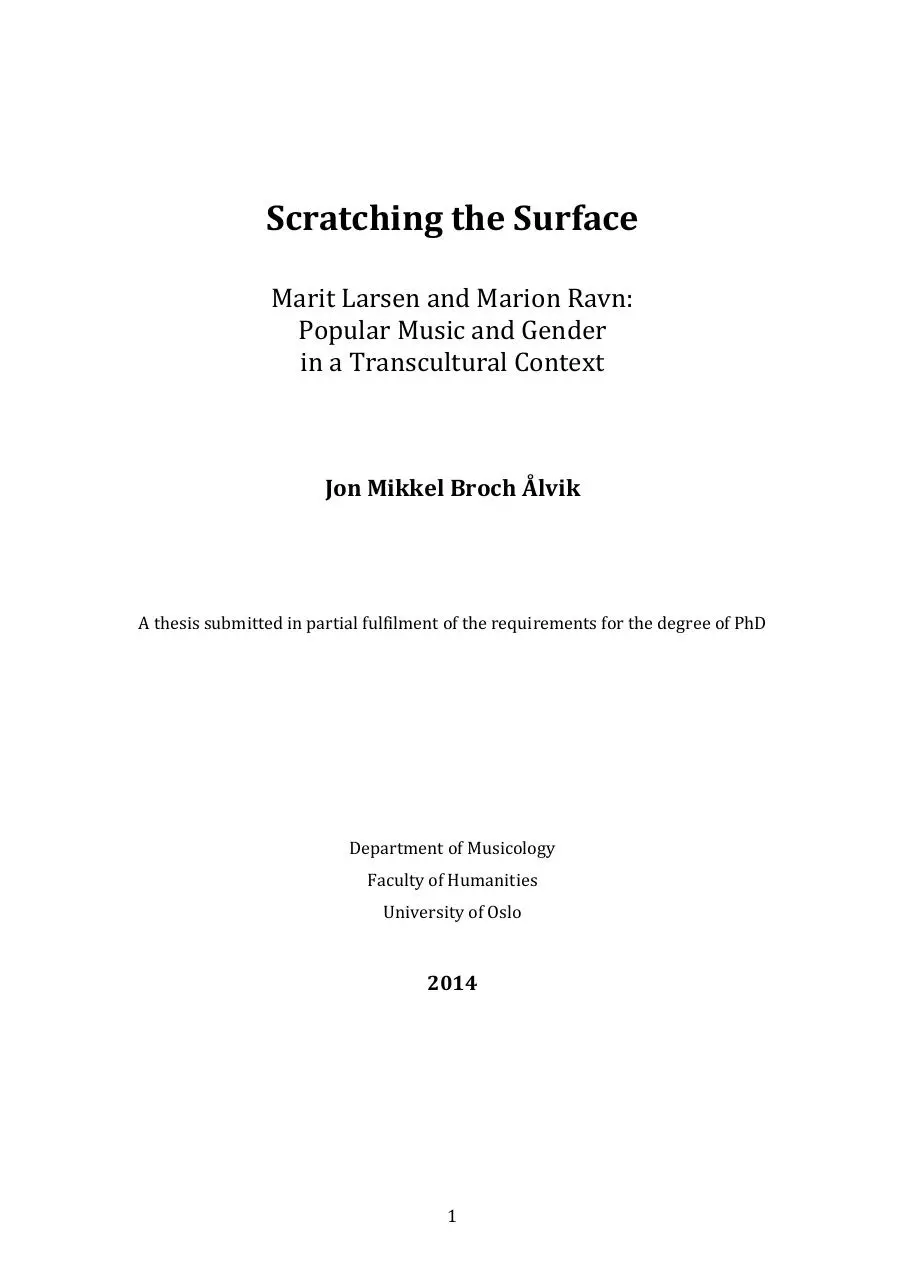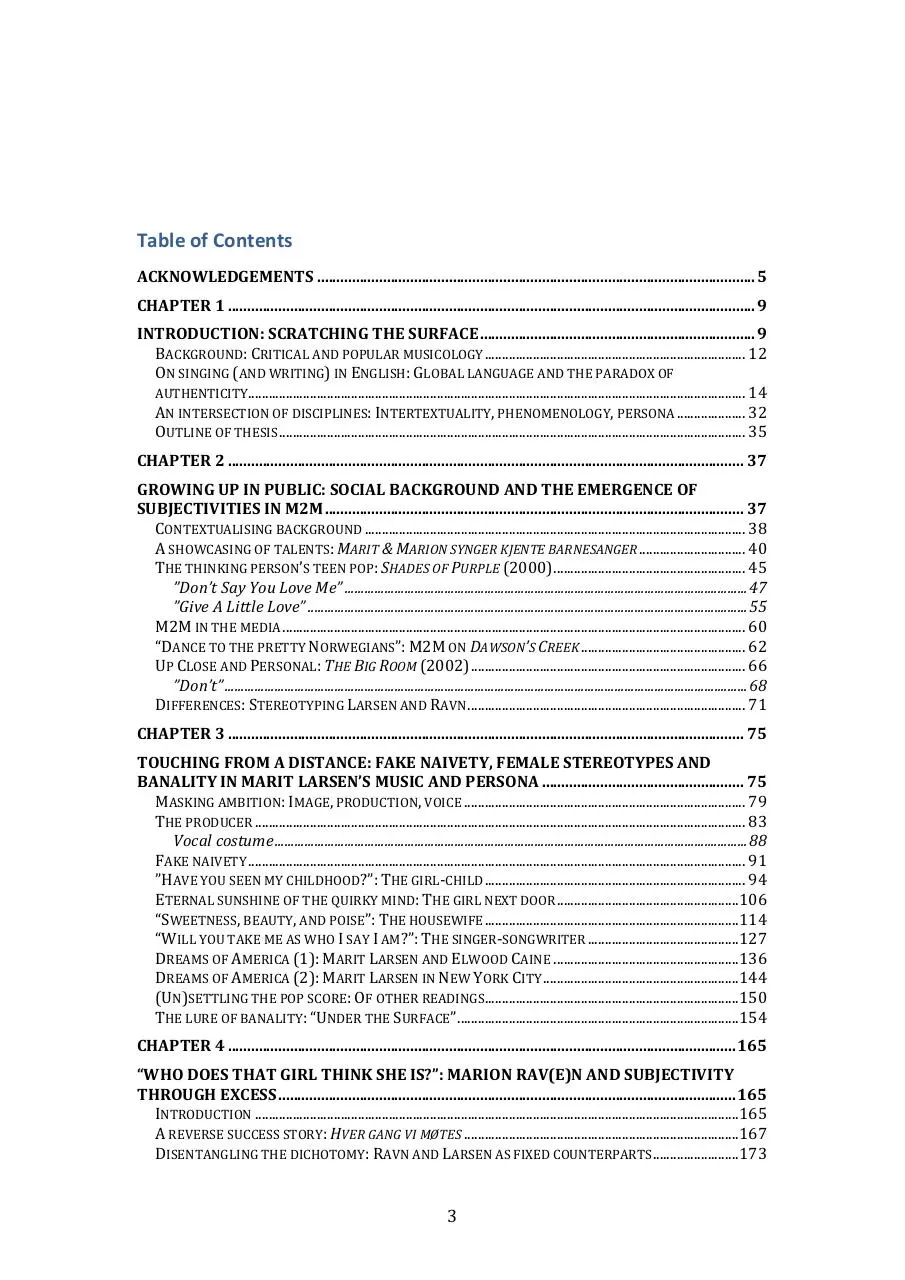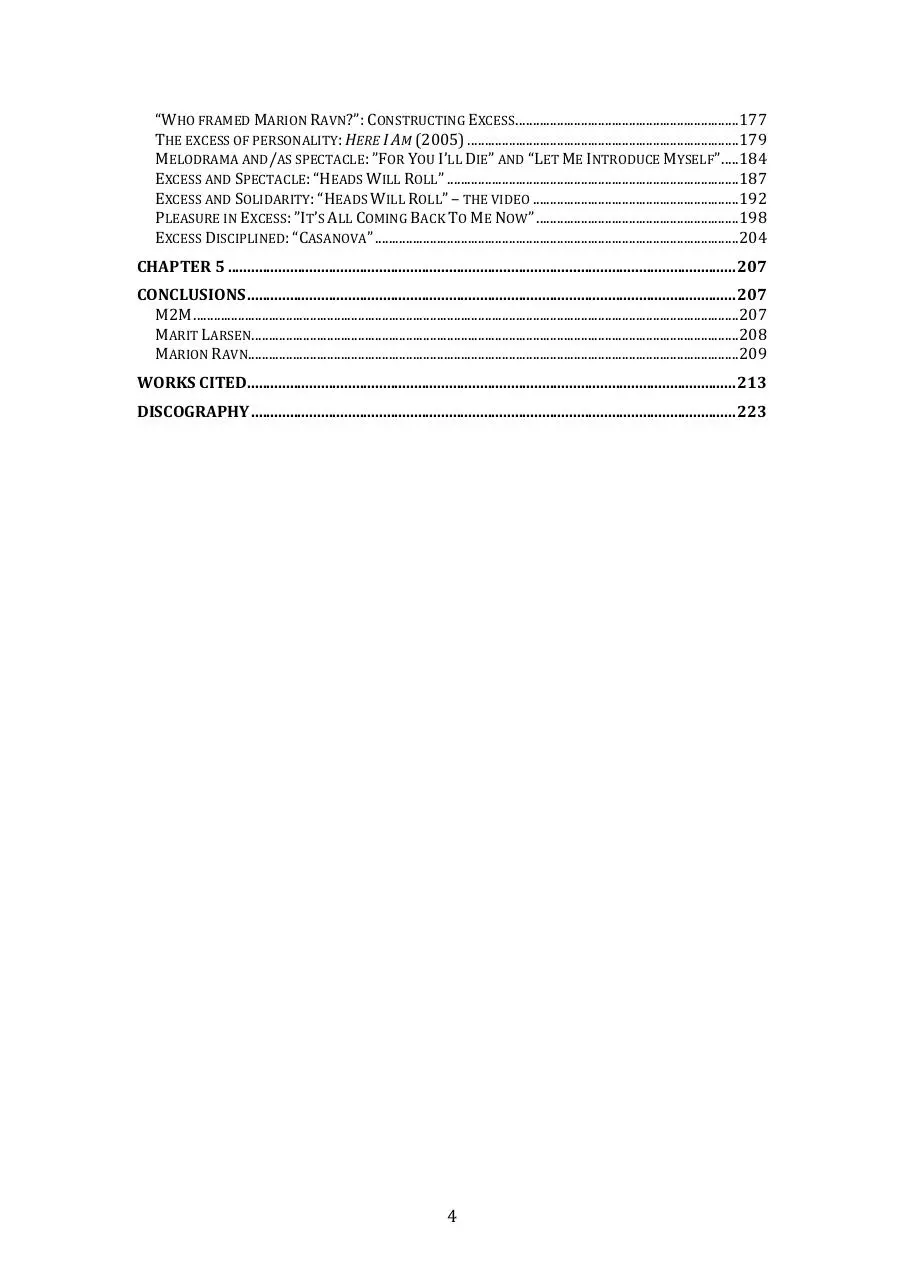Scratching the Surface (PDF)
File information
Title: Ã…lvik-PHD-trykk.pdf
Author: Jon Mikkel Broch Ã…lvik
This PDF 1.3 document has been generated by Microsoft Word / Mac OS X 10.6.8 Quartz PDFContext, and has been sent on pdf-archive.com on 25/09/2016 at 03:01, from IP address 24.5.x.x.
The current document download page has been viewed 370 times.
File size: 14.37 MB (223 pages).
Privacy: public file





File preview
Scratching the Surface
Marit Larsen and Marion Ravn:
Popular Music and Gender
in a Transcultural Context
Jon Mikkel Broch Ålvik
A thesis submitted in partial fulfilment of the requirements for the degree of PhD
Department of Musicology
Faculty of Humanities
University of Oslo
2014
1
2
Table of Contents
ACKNOWLEDGEMENTS ................................................................................................................. 5
CHAPTER 1 ........................................................................................................................................ 9
INTRODUCTION: SCRATCHING THE SURFACE....................................................................... 9
BACKGROUND: CRITICAL AND POPULAR MUSICOLOGY ............................................................................ 12
ON SINGING (AND WRITING) IN ENGLISH: GLOBAL LANGUAGE AND THE PARADOX OF
AUTHENTICITY................................................................................................................................................. 14
AN INTERSECTION OF DISCIPLINES: INTERTEXTUALITY, PHENOMENOLOGY, PERSONA .................... 32
OUTLINE OF THESIS ........................................................................................................................................ 35
CHAPTER 2 ..................................................................................................................................... 37
GROWING UP IN PUBLIC: SOCIAL BACKGROUND AND THE EMERGENCE OF
SUBJECTIVITIES IN M2M............................................................................................................ 37
CONTEXTUALISING BACKGROUND ............................................................................................................... 38
A SHOWCASING OF TALENTS: MARIT & MARION SYNGER KJENTE BARNESANGER ............................... 40
THE THINKING PERSON’S TEEN POP: SHADES OF PURPLE (2000)........................................................ 45
”Don’t Say You Love Me” .........................................................................................................................47
”Give A Little Love” ....................................................................................................................................55
M2M IN THE MEDIA ....................................................................................................................................... 60
“DANCE TO THE PRETTY NORWEGIANS”: M2M ON DAWSON’S CREEK ................................................ 62
UP CLOSE AND PERSONAL: THE BIG ROOM (2002)................................................................................ 66
”Don’t” .............................................................................................................................................................68
DIFFERENCES: STEREOTYPING LARSEN AND RAVN ................................................................................. 71
CHAPTER 3 ..................................................................................................................................... 75
TOUCHING FROM A DISTANCE: FAKE NAIVETY, FEMALE STEREOTYPES AND
BANALITY IN MARIT LARSEN’S MUSIC AND PERSONA .................................................... 75
MASKING AMBITION: IMAGE, PRODUCTION, VOICE .................................................................................. 79
THE PRODUCER ............................................................................................................................................... 83
Vocal costume..............................................................................................................................................88
FAKE NAIVETY ................................................................................................................................................. 91
”HAVE YOU SEEN MY CHILDHOOD?”: THE GIRL-‐CHILD ............................................................................ 94
ETERNAL SUNSHINE OF THE QUIRKY MIND: THE GIRL NEXT DOOR .....................................................106
“SWEETNESS, BEAUTY, AND POISE”: THE HOUSEWIFE ..........................................................................114
“WILL YOU TAKE ME AS WHO I SAY I AM?”: THE SINGER-‐SONGWRITER ............................................127
DREAMS OF AMERICA (1): MARIT LARSEN AND ELWOOD CAINE ......................................................136
DREAMS OF AMERICA (2): MARIT LARSEN IN NEW YORK CITY .........................................................144
(UN)SETTLING THE POP SCORE: OF OTHER READINGS..........................................................................150
THE LURE OF BANALITY: “UNDER THE SURFACE”..................................................................................154
CHAPTER 4 ...................................................................................................................................165
“WHO DOES THAT GIRL THINK SHE IS?”: MARION RAV(E)N AND SUBJECTIVITY
THROUGH EXCESS......................................................................................................................165
INTRODUCTION .............................................................................................................................................165
A REVERSE SUCCESS STORY: HVER GANG VI MØTES ................................................................................167
DISENTANGLING THE DICHOTOMY: RAVN AND LARSEN AS FIXED COUNTERPARTS .........................173
3
“WHO FRAMED MARION RAVN?”: CONSTRUCTING EXCESS .................................................................177
THE EXCESS OF PERSONALITY: HERE I AM (2005) ...............................................................................179
MELODRAMA AND/AS SPECTACLE: ”FOR YOU I’LL DIE” AND “LET ME INTRODUCE MYSELF”.....184
EXCESS AND SPECTACLE: “HEADS WILL ROLL” .....................................................................................187
EXCESS AND SOLIDARITY: “HEADS WILL ROLL” – THE VIDEO ............................................................192
PLEASURE IN EXCESS: ”IT’S ALL COMING BACK TO ME NOW” ...........................................................198
EXCESS DISCIPLINED: “CASANOVA” ..........................................................................................................204
CHAPTER 5 ...................................................................................................................................207
CONCLUSIONS..............................................................................................................................207
M2M...............................................................................................................................................................207
MARIT LARSEN..............................................................................................................................................208
MARION RAVN...............................................................................................................................................209
WORKS CITED..............................................................................................................................213
DISCOGRAPHY.............................................................................................................................223
4
Acknowledgements
This study was made possible by a three-‐year PhD grant from the Faculty of
Humanities at the University of Oslo. I am grateful to the Faculty for this
opportunity, and to the Department of Musicology for providing a stimulating
and hospitable work environment.
During this time I have benefited from being included in the research project
Popular Music and Gender in a Transcultural Context, also at the University of
Oslo, and led by Professor Stan Hawkins. I express my gratitude to my colleagues
on the project, PhD student Birgitte Sandve, postdoctoral fellow Mats Johansson,
and research assistant Mari Paus, for an inspiring and adventurous time together
on the project.
My research was considerably enhanced by a research visit to Canada in the
autumn semester of 2012. I am especially grateful to Professor Susan Fast at
McMaster University and Associate Professor Jacqueline Warwick at Dalhousie
University for offering feedback to my research, and for allowing me the
opportunity to present portions of my work-‐in-‐progress to their students in
designated seminars. Thanks also go to Professor David Brackett at McGill
University for feedback and fruitful discussions. My warmest thanks to Craig
Jennex and Alyssa Watt for housing in Hamilton (and an extra cheers to Craig
and crew, notably Simon, Matt and Jordan, for memorable evenings), and to
Steven Baur, Sophie, and Adam for their hospitality in Halifax. Christina Baade,
Lesley Brechin, Mariana Costa, Ryan McNutt and crew, and Laura Wiebe also
contributed to making my stay in Canada so enjoyable; thank you all for your
generosity.
I have also had the opportunity to present my work in seminars and symposiums
in Paris, Turku, Berlin, Kristiansand, and aboard the Color Line. I wish to thank
Susanne Binas-‐Preisendörfer, Barbara Bradby, Terence Cave, Tor Dybo, Nina
Eidsheim, Steven Feld, Erling E. Guldbrandsen, Karin Gundersen, Thomas Hilder,
5
Jakob Lothe, Susan McClary, Michael Rauhut, John Richardson, Derek B. Scott,
Odd Skårberg, Erik Steinskog, Will Straw, Robert Walser, and Peter Wicke for
providing feedback and advice in various stages of the project.
Thanks go to my fellow PhD students in Oslo, Ragnhild Brøvig-‐Hanssen, Kjetil
Klette Bøhler, Bjørn Morten Christophersen, Mari Romarheim Haugen, Erlend
Hegdal, Anita Høyvik, and Thomas Erma Møller, and postdoctoral fellows Peter
Edwards and Yngvar Kjus, for inspirational discussions. On that note, I wish to
express special thanks to Eirik Askerøi, Marita Buanes Djupvik, Lars K. Norberg,
and Eystein Sandvik for valuable conversations and advice.
Thanks also go to my colleagues at large at the Department for their kindness
and support, notably Professor Arnfinn Bø-‐Rygg for his inspirational courses,
Professor Rolf Inge Godøy for offering insights into phenomenology, Professor
Even Ruud for advice on identity studies, research assistant Ragnhild T. Solberg
for helping out with the project, and Professor Ståle Wikshåland for sharing his
knowledge on music journalism.
Outside the academy, thanks are due to Thomas Brun and Marius Graff for
generously giving of their time to answer questions, and to everyone from the
world of publishing who has provided material for my research: Hanne
Danielsen (Elle), Espen Holtestaul (No Comprendo Press), Kjersti Kvam
(Kamille), Heidi Sinding-‐Larsen (Woman), and Maria Kvalheim Steen (Henne).
Merci encore à Monique et François for their hospitality in Antibes. Thanks also
go to Arve T. Thorsen and Lokomotiv ZEB for quiz nights, and Morgenbladet for
providing a platform for my research in the form of record reviews.
Several individuals have contributed in various ways to my project at one time or
another, and I wish to extend my gratitude to the following people: Nina Ring
Aamundsen, Njål Hole Albrechtsen, Pål Angelskår, Per Holger Broch, Terje
Engen, Synnøve Engevik and the staff at Rockheim, Andy Evans, Flamme Forlag
(Nils-‐Øivind Haagensen and Bendik Wold), Ole Martin Halck, Happily Ever After
6
(Tommy, Janne, and Marius), Stig Rune Haugen (and the wonderful
Smekingarna), Hildebrand (Thomas, Gjermund, and Gaute), Mette Karlsvik,
Ingrid Lamark, Kyrre Tromm Lindvig, Einar Lukerstuen, and Nina Odegard and
Øyvind Risberg and their very musical family.
Special thanks to my closest friends for keeping me on track: Ola Alnæs, Karim
Bennis, Mari Blekastad, Ola Hansen, Christine Hoel, and Karstein Volle; and to the
masters and mistresses of IDL for their significant contribution.
Thanks to my close family, Nina Broch, Siri Dennis, and Trond Ålvik, for being
there even when I keep them at arm’s length for the sake of research; and my
family-‐in-‐law, especially Inger Anne, Yaya, Jan, Andreas, and Eva, for their
support.
Finally, two people deserve special mention, as the completion of this project
would not have been possible without them. My supervisor, Professor Stan
Hawkins at the Department of Musicology, University of Oslo, has provided sharp
readings of my material, ample advice and encouragement, and retained his faith
in my ideas from the start; my deepest appreciation goes to you for your
generosity, your support, and your unwavering confidence in me.
Mari Barwin remains my best conversation partner, my staunchest critic, and my
greatest supporter, and has provided every possible means for inspiring and
encouraging me throughout the period – a husband could not wish for more, nor
can he imagine being able to complete this thesis without your efforts. With all
my love and gratitude: This one’s for you.
Oslo, 27 February 2014
Jon Mikkel Broch Ålvik
7
8
Chapter 1
Introduction: Scratching the Surface
In the late summer of 2002, Norwegian newspapers broadly documented the
break-‐up of the duo M2M. The members, 18-‐year-‐old Marion Ravn (listed as
Marion Raven on the duo’s record covers) and 19-‐year-‐old Marit Larsen, had
been the subjects of extensive press coverage in Norway during their four years
as a band, starting in 1998 with the much-‐published news that they had been
offered a recording contract with the Atlantic Recording Corporation in the USA.
In the space of the next two years, M2M rose to worldwide fame thanks to the
inclusion of their first single, “Don’t Say You Love Me”, on the international
soundtrack to Pokémon: The First Movie, and the release of their first album,
Shades of Purple, in 2000. After the release of their follow-‐up album The Big
Room two years later, the media peddled stories of dwindling sales and
unfulfilled expectations, but also interviews with the two artists, who insisted
that nobody told them what to do, and that they were doing what they wanted as
a band, regardless of what their employer decreed. Then, in late July, came the
news that the duo had been taken off their summer tour of the USA as support
act for singer-‐songwriter and label mate, Jewel. In at least one interview, they
stressed the fact that this was a decision taken by the company, and that they
had no control of the situation.1
Shortly afterwards, the newspapers wrote that the duo had disbanded. Almost
immediately, the news broke that Atlantic had offered Ravn a solo contract. The
press jumped at the chance, and Ravn became the subject of equally intense
press coverage for the next couple of years. In 2005, she released her first album,
Here I Am, which received favourable reviews overall, but journalists also
remarked the lack of global success that they expected such a release to
generate.
1 Grimsæth, Andreas & Hansen, Espen A.: “M2M-‐turneen avbrutt”, Verdens Gang 22 July 2002, p.
42.
9
Download Scratching the Surface
Scratching the Surface.pdf (PDF, 14.37 MB)
Download PDF
Share this file on social networks
Link to this page
Permanent link
Use the permanent link to the download page to share your document on Facebook, Twitter, LinkedIn, or directly with a contact by e-Mail, Messenger, Whatsapp, Line..
Short link
Use the short link to share your document on Twitter or by text message (SMS)
HTML Code
Copy the following HTML code to share your document on a Website or Blog
QR Code to this page

This file has been shared publicly by a user of PDF Archive.
Document ID: 0000486754.